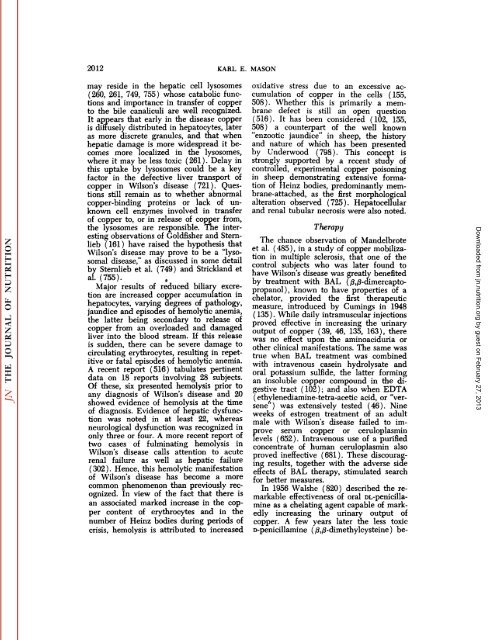conspectus of researchon copper metabolism and requirements
conspectus of researchon copper metabolism and requirements
conspectus of researchon copper metabolism and requirements
You also want an ePaper? Increase the reach of your titles
YUMPU automatically turns print PDFs into web optimized ePapers that Google loves.
2012 KARL E. MASON<br />
may reside in the hepatic cell lysosomes<br />
(260, 261, 749, 755) whose catabolic func<br />
tions <strong>and</strong> importance in transfer <strong>of</strong> <strong>copper</strong><br />
to the bile canaliculi are well recognized.<br />
It appears that early in the disease <strong>copper</strong><br />
is diffusely distributed in hepatocytes, later<br />
as more discrete granules, <strong>and</strong> that when<br />
hepatic damage is more widespread it be<br />
comes more localized in the lysosomes,<br />
where it may be less toxic ( 261 ). Delay in<br />
this uptake by lysosomes could be a key<br />
factor in the defective liver transport <strong>of</strong><br />
<strong>copper</strong> in Wilson's disease (721). Ques<br />
tions still remain as to whether abnormal<br />
<strong>copper</strong>-binding proteins or lack <strong>of</strong> un<br />
known cell enzymes involved in transfer<br />
<strong>of</strong> <strong>copper</strong> to, or in release <strong>of</strong> <strong>copper</strong> from,<br />
the lysosomes are responsible. The inter<br />
esting observations <strong>of</strong> Goldfisher <strong>and</strong> Sternlieb<br />
(161) have raised the hypothesis that<br />
Wilson's disease may prove to be a "lysosomal<br />
disease," as discussed in some detail<br />
by Sternlieb et al. (749) <strong>and</strong> Strickl<strong>and</strong> et<br />
al. (755). f<br />
Major results <strong>of</strong> reduced biliary excre<br />
tion are increased <strong>copper</strong> accumulation in<br />
hepatocytes, varying degrees <strong>of</strong> pathology,<br />
jaundice <strong>and</strong> episodes <strong>of</strong> hemolytic anemia,<br />
the latter being secondary to release <strong>of</strong><br />
<strong>copper</strong> from an overloaded <strong>and</strong> damaged<br />
liver into the blood stream. If this release<br />
is sudden, there can be severe damage to<br />
circulating erythrocytes, resulting in repet<br />
itive or fatal episodes <strong>of</strong> hemolytic anemia.<br />
A recent report (516) tabulates pertinent<br />
data on 18 reports involving 28 subjects.<br />
Of these, six presented hemolysis prior to<br />
any diagnosis <strong>of</strong> Wilson's disease <strong>and</strong> 20<br />
showed evidence <strong>of</strong> hemolysis at the time<br />
<strong>of</strong> diagnosis. Evidence <strong>of</strong> hepatic dysfunc<br />
tion was noted in at least 22, whereas<br />
neurological dysfunction was recognized in<br />
only three or four. A more recent report <strong>of</strong><br />
two cases <strong>of</strong> fulminating hemolysis in<br />
Wilson's disease calls attention to acute<br />
renal failure as well as hepatic failure<br />
(302). Hence, this hemolytic manifestation<br />
<strong>of</strong> Wilson's disease has become a more<br />
common phenomenon than previously rec<br />
ognized. In view <strong>of</strong> the fact that there is<br />
an associated marked increase in the cop<br />
per content <strong>of</strong> erythrocytes <strong>and</strong> in the<br />
number <strong>of</strong> Heinz bodies during periods <strong>of</strong><br />
crisis, hemolysis is attributed to increased<br />
oxidative stress due to an excessive ac<br />
cumulation <strong>of</strong> <strong>copper</strong> in the cells (155,<br />
508). Whether this is primarily a mem<br />
brane defect is still an open question<br />
(516). It has been considered (102, 155,<br />
508) a counterpart <strong>of</strong> the well known<br />
"enzootic jaundice" in sheep, the history<br />
<strong>and</strong> nature <strong>of</strong> which has been presented<br />
by Underwood (798). This concept is<br />
strongly supported by a recent study <strong>of</strong><br />
controlled, experimental <strong>copper</strong> poisoning<br />
in sheep demonstrating extensive forma<br />
tion <strong>of</strong> Heinz bodies, predominantly mem<br />
brane-attached, as the first morphological<br />
alteration observed (725). Hepatocellular<br />
<strong>and</strong> renal tubular necrosis were also noted.<br />
Therapy<br />
The chance observation <strong>of</strong> M<strong>and</strong>elbrote<br />
et al. (485), in a study <strong>of</strong> <strong>copper</strong> mobiliza<br />
tion in multiple sclerosis, that one <strong>of</strong> the<br />
control subjects who was later found to<br />
have Wilson's disease was greatly benefited<br />
by treatment with BAL (/3,/3-dimercaptopropanol),<br />
known to have properties <strong>of</strong> a<br />
chelator, provided the first therapeutic<br />
measure, introduced by Cumings in 1948<br />
( 135). While daily intramuscular injections<br />
proved effective in increasing the urinary<br />
output <strong>of</strong> <strong>copper</strong> (39, 46, 135, 163), there<br />
was no effect upon the aminoaciduria or<br />
other clinical manifestations. The same was<br />
true when BAL treatment was combined<br />
with intravenous casein hydrolysate <strong>and</strong><br />
oral potassium sulfide, the latter forming<br />
an insoluble <strong>copper</strong> compound in the di<br />
gestive tract (102); <strong>and</strong> also when EDTA<br />
( ethylenediamine-tetra-acetic acid, or "ver<br />
sene") was extensively tested (46). Nine<br />
weeks <strong>of</strong> estrogen treatment <strong>of</strong> an adult<br />
male with Wilson's disease failed to im<br />
prove serum <strong>copper</strong> or ceruloplasmin<br />
levels (652). Intravenous use <strong>of</strong> a purified<br />
concentrate <strong>of</strong> human ceruloplasmin also<br />
proved ineffective (681). These discourag<br />
ing results, together with the adverse side<br />
effects <strong>of</strong> BAL therapy, stimulated search<br />
for better measures.<br />
In 1956 Walshe (820) described the re<br />
markable effectiveness <strong>of</strong> oral DL-penicillamine<br />
as a chelating agent capable <strong>of</strong> mark<br />
edly increasing the urinary output <strong>of</strong><br />
<strong>copper</strong>. A few years later die less toxic<br />
D-penicillamine (ß,/3-dimethylcysteine) be-<br />
Downloaded from<br />
jn.nutrition.org<br />
by guest on February 27, 2013
















